Introduction
There are five species of baboons and they all live in Africa – olive, yellow, chacma, Guinea and sacred. Olive baboons (Papio anubis) – so called because of their green-grey coat – are the most widely distributed, living in 25 African countries, including Uganda.1https://primate.wisc.edu/primate-info-net/pin-factsheets/pin-factsheet-olive-baboon They have a bit of a ‘bad lad’ reputation! In fact, they are hardy and adaptable – and need to be in their changing and threatened landscapes. There isn’t any reliable data about the baboon population in Africa, or Uganda specifically, but their numbers are considered stable.2https://www.iucnredlist.org/species/40647/17953200 Baboons prefer roaming on the ground of the savannah and other drier habitats over tropical forests3https://ugandawildlife.org/animals/baboon/, but in Uganda they can be found in Bwindi Impenetrable Forest, Kibale, Murchison Falls and Queen Elizabeth National Parks and Budongo Forest Reserve.2https://www.iucnredlist.org/species/40647/17953200
Olive baboons live, on average, for 25 to 30 years in the wild. The average height for males is 2.3 feet (70cm) not including their tail and they weigh about 3.7 stone (24 kg) – twice as big as the average female.1https://primate.wisc.edu/primate-info-net/pin-factsheets/pin-factsheet-olive-baboon
Fascinating facts
Old world monkeys
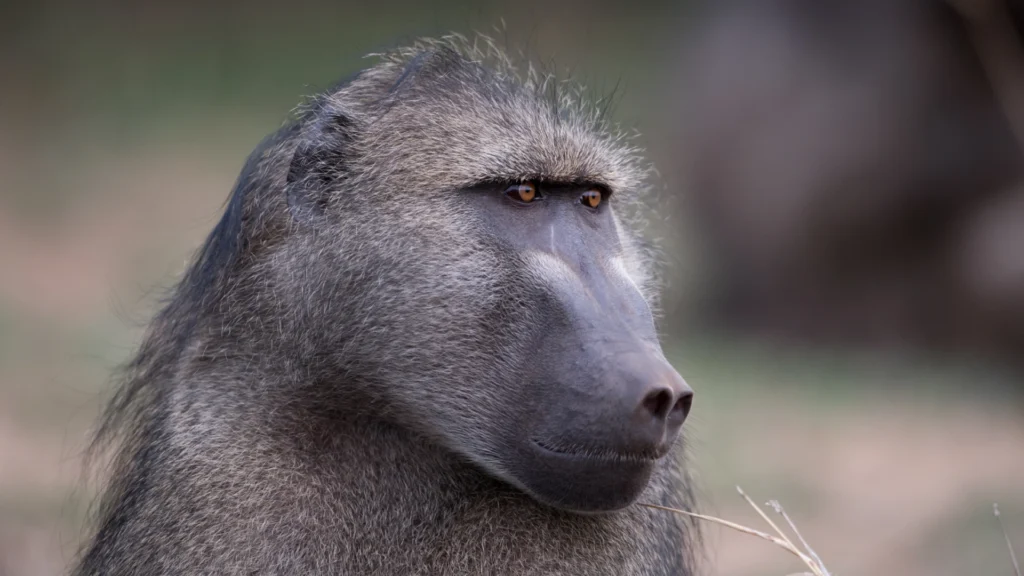
There are two main groups of monkeys: Old World, referring to monkeys found in Asia and Africa, and New World, referring to monkeys found in the Americas. Baboons belong to the family of Old World monkeys, and like other family members, they have a tail but it is not prehensile, meaning they can’t wrap it around branches to help them swing or hang from trees – but they are still good climbers. Olive baboons have dog-like noses, powerful jaws and long canine teeth (mainly used as weapons), which are sharpened against specialised lower teeth. Males have a longer mane around their neck called a ruff.
A baboon’s bum

When a female olive baboon is ready to mate, her bottom swells up and turns bright red. This might look a bit off-putting to us, but it’s very attractive to male baboons. Once the female’s bottom returns to its normal size, the males are no longer interested.4https://www.britannica.com/animal/baboon#ref1043836
Baby baboons
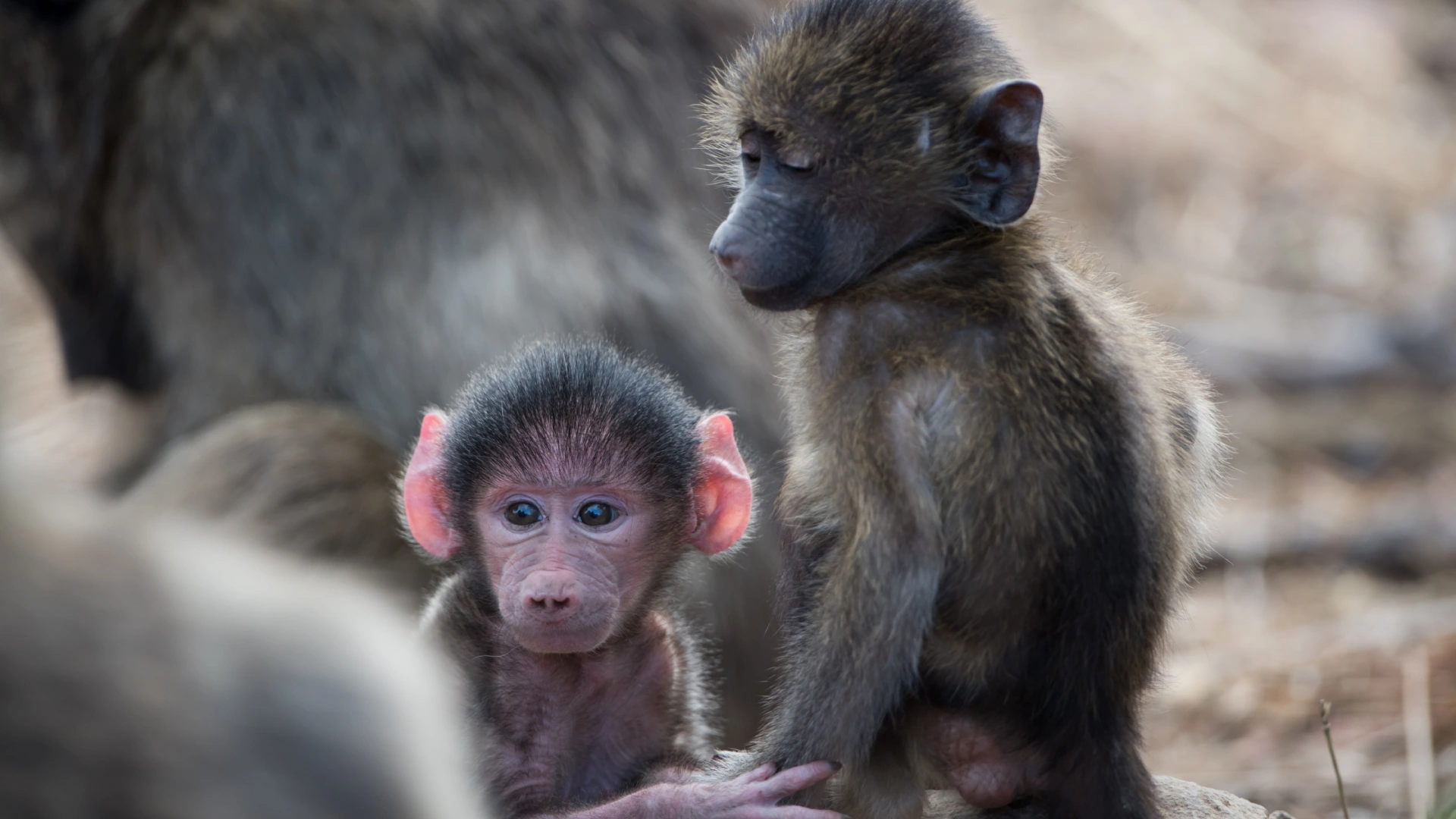
A pregnant baboon gives birth to one infant after a six-month pregnancy. When born, the baby baboon is covered in black fur and totally dependent on their mother and instinctually grips onto her fur to be carried around. As they get a bit older, they ride around on their mother’s back. Within a few weeks the infant will be on their feet, roaming around and exploring their new world. They do not venture far though, for the first few months, and mothers are quick to scoop them back if they feel separated for too long.
Babies are weaned at about one year. They are extremely playful (and very funny to watch!). Now both males and females take care of the mischievous youngsters. Males often groom and babysit while females look for food, teaching the youngsters how to behave in the group.
Sexual maturity occurs between the ages of 4-6, but fully grown adulthood is not reached until 7-10 years.
Mum’s the word

Mother baboons are extremely protective – not just of their own infants, but of all the infants in the troop. They work together to protect them and teach them lessons. If the infant baboon is female, she will inherit the same rank as her mother in the troop. However, if the infant is male, he’ll usually leave his origin troop to join another. As many of the females in a troop are related, this helps diversify the gene pool and avoid inbreeding.5https://www.animalfactsencyclopedia.com/Baby-baboon.html
Opportunistic primates

Baboons are omnivores but the bulk of their diet is plant-based. They eat fruits, grasses, seeds, tubers, roots, leaves and bark. They’re not fussy though and will eat whatever they can get their hands on… including invertebrates (grasshoppers, spiders, eggs and shellfish etc ) and small animals from time-to-time which they may hunt alone or cooperatively in groups. Olive baboons have cheek pouches where they can stuff food as they move about foraging. Baboons that live close to human settlements often try to supplement their diet with farmers’ or garden crops, or with food garbage.6https://www.torontozoo.com/animals/Olive%20baboon
A strong leader
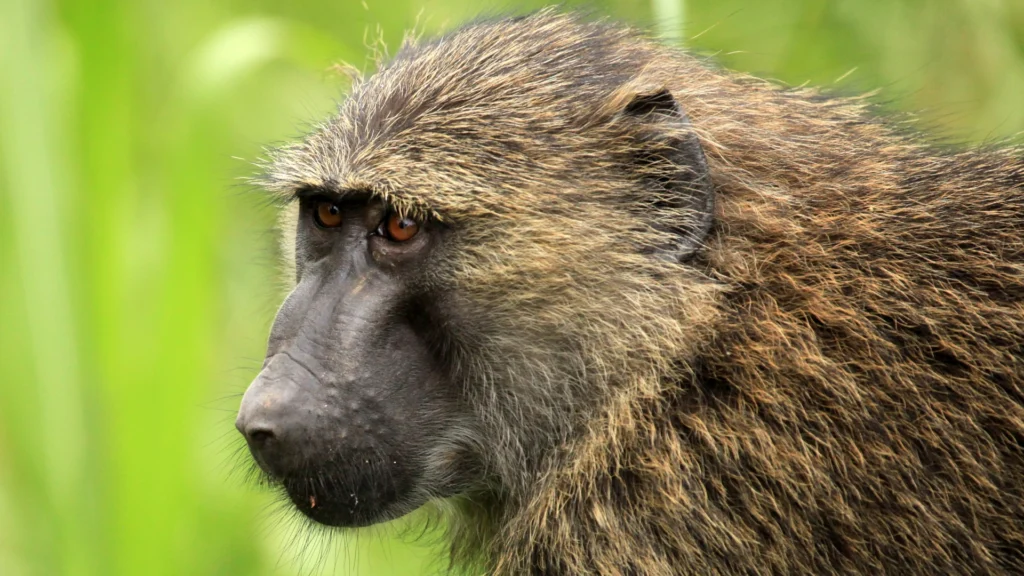
Olive baboons live in troops of around 50 members, but they can even be as large as 250 individuals. Hierarchy among males is based on brute strength, with the biggest and strongest being the boss. But baboons show a lot of tenderness too. They form bonds and make friends by grooming each other to remove insects, parasites and dead skin.1https://primate.wisc.edu/primate-info-net/pin-factsheets/pin-factsheet-olive-baboon
Gang members
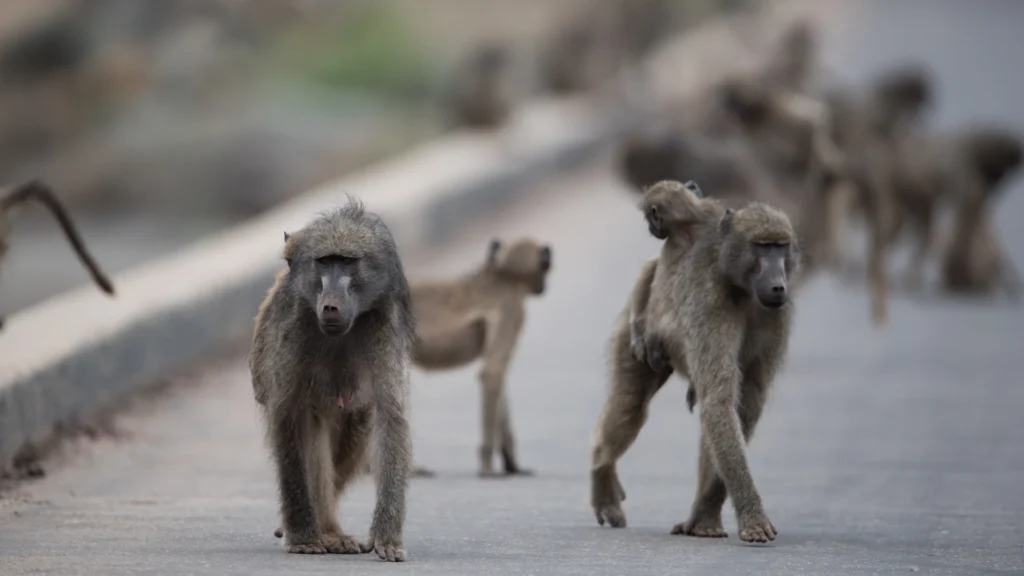
Olive baboons are highly intelligent and have complex social relationships. Males are in constant competition and ascend and descend rank throughout their life. The females are important as peacekeepers and leading their family to food. Olive baboons form close and long-lasting relationships between males and females, and females often choose their close friends over high status males to mate with.
A day in the life

Baboons are diurnal (active in the day and sleep at night) and spend most of their day on the ground. They start the day playing and socialising and then travel as a family to feed. The juveniles lead, followed by females and young juveniles, then older males, mothers and infants, with young males at the rear.6https://www.torontozoo.com/animals/Olive%20baboon They rest at high heat and then continue to forage. As the evening draws in, the baboons return to their sleeping area and socialise before bed. They tend to choose safety over comfort for their sleeping sites – often high rocky cliffs, or tall trees where they are safe from predators.
On the look out

Olive baboons have several predators including the big cats such as lions and leopards, as well as hyenas, wild dogs, crocodiles and even chimpanzees. The young are also hunted by raptors such as eagles.
Complex communicators
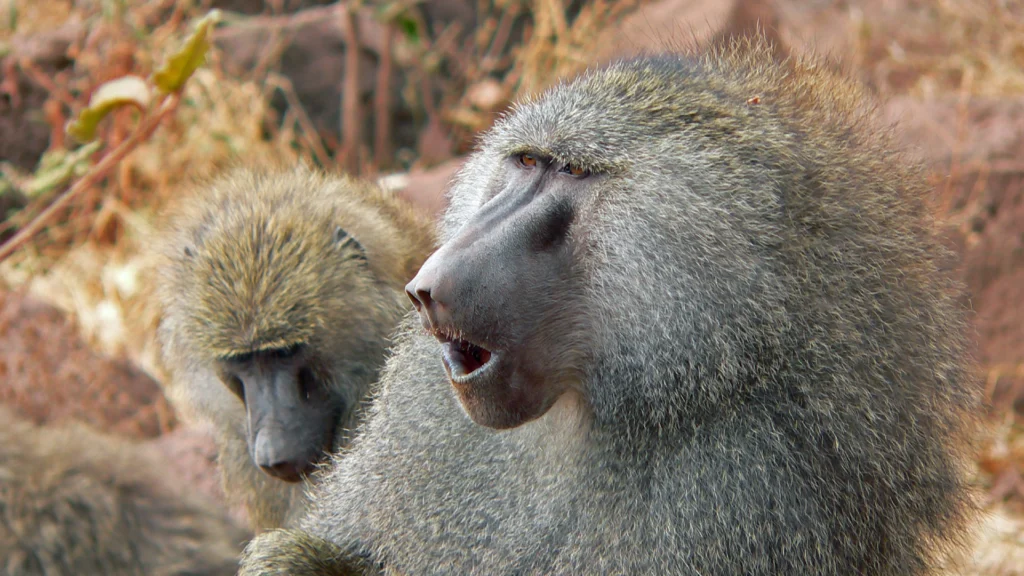
Baboons have many complex ways to communicate with each other. They make vocalisations, use facial expressions, posturing, and gesturing to talk to one another. Their main way of communicating is through facial gestures and body language. To show aggression they might open their mouth and bare their canine teeth but they also have subtler forms of expression such as raising an eyebrow and showing the whites of their eyes to express displeasure.7https://www.encyclopedia.com/science/encyclopedias-almanacs-transcripts-and-maps/baboons
Threats to olive baboons
Habitat loss
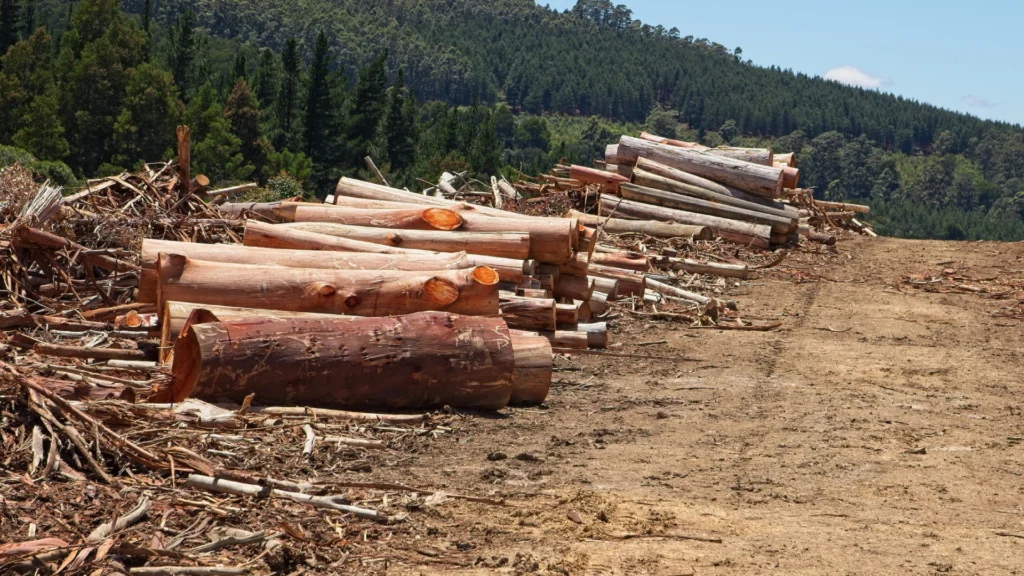
As the human population in Uganda increases, more land is converted into settlements and farmland, and fragmented by roads. The growth of animal agriculture in Uganda is a direct cause of habitat loss. As a result of Uganda’s population growth, increased urbanisation, and an increased income for wealthier Ugandans, the demand for animal products is likely to dramatically rise in the coming years. The FAO estimates that by 2050, the demand for meat and milk products in Uganda will more than double and “the production of all types of meat and that of milk will increase by 164 and 41 per cent, respectively.”8https://www.fao.org/3/ca7009en/CA7009EN.pdf
In order to produce these animal products, land that was once beautiful and iconic savannah and forest – and a home to Uganda’s majestic wildlife – is being turned into farmland. The conversion of land to agriculture is stripping the wildlife of its natural habitat and putting increasing pressure upon the land to support life. In the last one hundred years, Uganda has lost 42 per cent of its forest cover, decreasing from 54 per cent to 12 per cent in 2017.9https://illuminem.com/illuminemvoices/deforestation-in-uganda-causes-and-recommendations Encroachment into Queen Elizabeth National Park by illegal cattle ranchers is common10https://conbio.onlinelibrary.wiley.com/doi/abs/10.1111/cobi.12538?campaign=woletoc and the National State of the Environment Report for Uganda 2014, attributes this to “the increasing demand of land for agriculture and fuel wood by the rapidly increasing population growth.”11https://nema.go.ug/sites/all/themes/nema/docs/FINAL%20NSOER%202014.pdf
Of course, a growing population needs food but it would be much more sustainable to meet these needs through the growing of crops instead of farming of animals. Animal agriculture requires by far the most land and resources – this is because land is not only used for grazing but also for growing food for the animals. The more animal-based foods we eat, the more endangered the natural habitats become. However, crops are a far more efficient way to feed the growing population and use less land and other natural resources. A vegan diet is associated with only half the cropland demand, grazing intensity and overall biomass harvest of meat-based diets12https://www.nature.com/articles/ncomms11382 so switching to a vegan diet would have a phenomenal impact on reducing deforestation and land degradation in Uganda.
Human-wildlife conflict

Although the baboon population is stable, they are a highly persecuted animal. They are often victims of trapping, shooting and poisoning campaigns carried out by farmers who have had their crops raided or livestock (usually sheep and goats) killed. In fact, baboons are listed as vermin under the African Convention.2https://www.iucnredlist.org/species/40647/17953200 A survey of Ethiopian farmers found that over 80 per cent of respondents had negative attitudes towards baboons, viewing them as pests and vermin, and even more did not care about conserving the monkeys.13https://www.sciencedirect.com/science/article/pii/S235198942100370X
The same views are expressed in Uganda, and therefore the same solutions apply. First and foremost, the baboons’ natural habitat needs to be protected so they have no need to raid farms. Secondly, farms should employ better guarding systems against raids, and thirdly people should be educated about the importance of baboons in the ecosystem. For example, baboons are prey animals for larger animals such as leopards, through digging for tubers in the earth they aerate the soil, and they also spread the seeds of the fruit they eat.
Hunting

In some regions, baboons are hunted for bushmeat. For poorer Ugandans, hunting and selling bushmeat at local markets is a source of income, and this boomed during the Covid-19 pandemic when ecotourism instantly collapsed.14https://www.nationalgeographic.com/animals/article/covid19-behind-uganda-poaching Although many Ugandans frown upon eating bushmeat from primates, many don’t even know they’re doing it. An investigation revealed that hunters often sell primate meat disguised as antelope and warthog.15https://www.sciencedirect.com/science/article/pii/S2352771421000410 This isn’t just terrible news for the baboons and other wildlife, but for humans too as primates can pass zoonotic diseases such as Ebola to humans. In fact, Uganda has been classed as a “hotspot” for potential zoonotic diseases due to the increasingly close and frequent contact between humans and wildlife as natural habitats are destroyed, reduced and encroached upon.16https://www.ncbi.nlm.nih.gov/pmc/articles/PMC4482355/ All the more reason to choose a plant-based diet!
References
References
- 1
- 2
- 3
- 4
- 5
- 6
- 7
- 8
- 9
- 10
- 11
- 12
- 13
- 14
- 15
- 16

